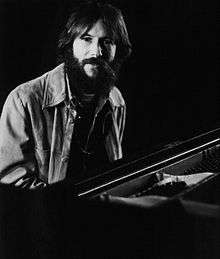Corky Siegel
| Corky Siegel | |
|---|---|
 Siegel in 1975. | |
| Background information | |
| Birth name | Mark Paul Siegel |
| Born | October 24, 1943 |
| Origin | Chicago, Illinois, United States |
| Genres | Blues, third stream, classical crossover |
| Occupation(s) | Musician, composer |
| Instruments | Harmonica, piano |
| Years active | 1964–present |
| Associated acts |
Siegel-Schwall Band Chamber Blues |
| Website | www.chamberblues.com |
Mark Paul "Corky" Siegel (born October 24, 1943) is an American musician, singer-songwriter, and composer. He plays harmonica and piano. He plays and writes blues and blues-rock music, and has also worked extensively on combining blues and classical music. He is best known as the co-leader of the Siegel-Schwall Band, and as the leader of the Chamber Blues group.[1][2][3]
Musical career
Corky Siegel's professional music career began in 1964, when he met guitarist Jim Schwall. Both were studying music at Roosevelt University in Chicago. The two became a duo, performing blues music. They landed a regular gig at Pepper's Lounge, where well known, established blues musicians such as Muddy Waters, Howlin' Wolf, and Willie Dixon would often sit in.[4] After a while the duo became a quartet, the Siegel-Schwall Band.
The Siegel-Schwall Band enjoyed increasing popularity, and by 1967 were touring nationally, playing at large rock venues like the Fillmore West and sharing the bill with famous rock bands.[5][6] Between 1966 and 1974, they released ten albums. After 1974, they stopped playing concerts, but the band re-formed in 1987. They still play occasional live dates and have released two albums of new material.[7] The band currently features drummer Sam Lay and bassist Rollo Radford; Lay played with Siegel in the Happy Year Band of 1973 which also featured Chicago blues guitarist Albert Joseph.
The idea of combining blues and classical music was first suggested by classical conductor Seiji Ozawa. Ozawa brought together the Siegel-Schwall Band and the Chicago Symphony Orchestra. They first performed "Three Pieces for Blues Band and Symphony Orchestra", by William Russo in 1968. In 1973, the band and Ozawa released a recording of this work performed with the San Francisco Symphony. In 1975, Siegel and Ozawa, with the San Francisco Symphony, first performed another William Russo work, "Street Music: A Blues Concerto". A recording of this piece was released in 1979.[8]
Inspired by his collaboration with Ozawa, Corky Siegel formed Chamber Blues in 1988. The group's music combines elements of classical, blues, and jazz. The band consists of a string quartet – two violins, a viola, and a cello – along with a percussionist Frank Donaldson, Siegel on harmonica, and sometimes doubling on piano. Chamber Blues is still together. The group has toured nationally and has released three albums.[9][10][11]
Siegel has also worked on numerous other musical projects. In 2004, he was a member of a band called the Chicago Blues Reunion, which released the album Buried Alive in the Blues.[12]
Book
With Peter Krammer, Corky Siegel wrote a book for musicians and music students, called Let Your Music Soar: The Emotional Connection. It was published by Nova Vista Publishing in 2007.
Discography
For Siegel's recordings with the Siegel-Schwall Band, see Siegel-Schwall Band.
- Corky Siegel – Corky Siegel (1974 – Dharma)
- Street Music: A Blues Concerto – San Francisco Symphony and Corky Siegel (1979 – Deutsche Grammophon)
- Out of the Blue – Corky Siegel (1980 – Stuff)
- Goodbye California - Corky Siegel (1984 - Skitzo/Frenia Records [re-release of Out of the Blue])
- Corky Siegel's Chamber Blues – Chamber Blues (1994 – Alligator)
- Complementary Colors – Chamber Blues (1998 – Gadfly)
- Solo Flight – Corky Siegel (1999 – Gadfly)
- Corky Siegel's Traveling Chamber Blues Show – Chamber Blues (2005 – Alligator)
- Buried Alive in the Blues – Chicago Blues Reunion (2005 – 33rd Street)
References
- ↑ Corky Siegel at AllMusic
- ↑ Corky Siegel interview on YouTube on WTTW public television
- ↑ Corky Siegel biograpny at the official Siegel-Schwall Band web site
- ↑ Widen, Larry (2005). Tombstone Blues. Apple Core Publishing Group. pp. 55–60. ISBN 1-4116-4823-4.
- ↑ Concert review of the Siegel-Schwall Band at the Fillmore West, Billboard, March 27, 1971, pp. 28, 44
- ↑ Milano, Dean (2009). The Chicago Music Scene: 1960s and 1970s. Arcadia Publishing. p. 47. ISBN 0-7385-7729-4.
- ↑ Siegel-Schwall Band at AllMusic
- ↑ "Corky Siegel's History and Tall Tales — The Symphonic Blues", chamberblues.com
- ↑ "Corky Siegel's Triple Blues Threat", National Public Radio, December 17, 2005
- ↑ Bessman, Jim. "Siegel Makes Concerts Crystal Clear" Billboard, February 12, 2000, pp. 38–39
- ↑ "About Chamber Blues", chamberblues.com
- ↑ Fricke, David. Buried Alive in the Blues review, Rolling Stone, November 17, 2005
External links
- Corky Siegel's Planet, the official website of Chamber Blues and the Siegel-Schwall Blues Band